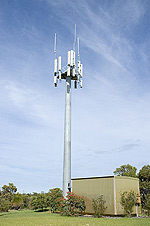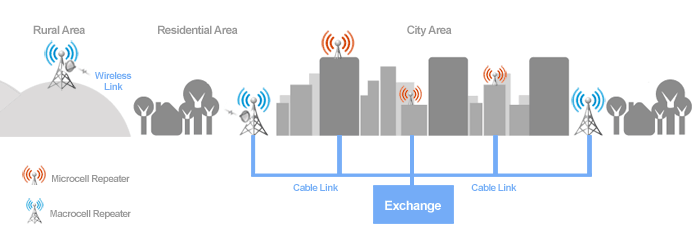
What is a Mobile Base Station?

A mobile base station sends/receives radio signals and is responsible for forming the cell area. A typical cell tower is made up of several parts:
(i) The antennas – to send and receive radio signals within the cell.
(ii) The tower or supporting structure – where the antennas are mounted, this could be a building, mast or tower.
(iii) Hardware – supports the operations of the base station often called the BTS (Base Transceiver Station) and is stored in a cabinet or shelter.
(iv) A link back to the digital exchange which can either be a cable or wireless connection.
Locate a Mobile Phone Tower
To locate a mobile base station in your area visit the AMTA Mobile Phone Tower Locator and enter your location. Tick the ‘Nearby Sites’ checkbox to see all towers on the map.
Base Stations - Types
| Base Station Type | Typical Coverage Radius | Typical Use |
| Femtocell | 10m | home or office use |
| Domestic Repeater | 100m | home, office or factory use |
| Picocell | 200m | high rise building, hotel or car park use |
| Microcell | 1-2km | shopping centers, transport hubs, mine sites, city block, temporary events or natural disasters. |
| Macrocell | 5-32km | suburban, city and rural use |
| Macrocell – Extended Reach | 50-150km using extender cell technology | suburban and rural use |
Base Stations - Cell Coverage
The cell coverage area is determined by the base station output power and the environment. Things such trees, hills, buildings and land formations will have an affect on the coverage area.

In city areas there is generally a larger number of users and also obstructions. To help compensate you will find a lot more base stations to cover demand, and the cell sizes will have a 2-5km radius. In country areas where there are large open spaces the base stations will be further apart and the cell radius will be around 10-32km. Using extender cell technology like that used by Telstra’s NextG™ network, a radius of 80-200km can be reached.
Base Stations - Capacity
A base station can only handle a certain number of calls at one time. A typical base station has about 168 voice channels available and once capacity is nearly reached the base station will seamlessly hand off a mobile user to another base station within the users range.
The base station will also have a limit to the amount of bandwidth available for internet and data use. With the introduction of smart phones, the carriers have had to increase the channel bandwidth and base stations to ensure the internet does not become slow during peak periods. The wider the channel bandwidth, the wider the pipe is to send data. Standard channel bandwidths used by the carriers in Australia are 10 MHz or 15 MHz. Vodafone plan on using 20MHz of bandwidth for 4G.
The term ‘backhaul’ is often used when referring to the size of the pipe providing internet to a base station.
